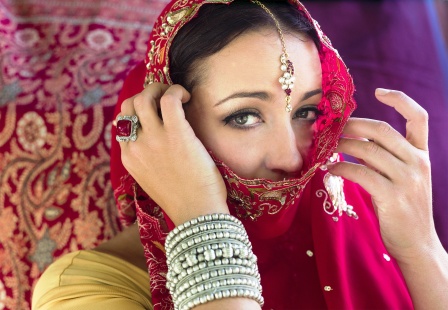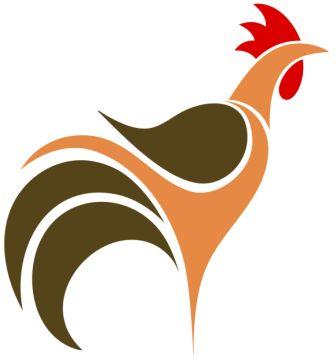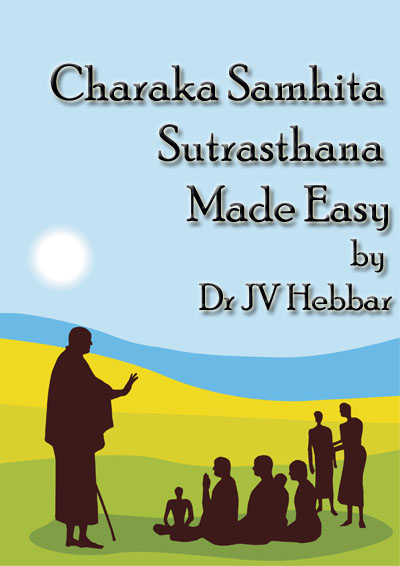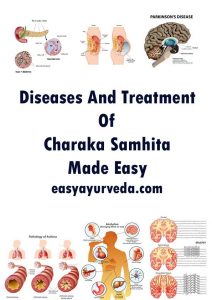Charaka Chikitsa 2.1 Samyoga Sharamuliya Vajikarana Pada
The 2nd chapter of Charak Samhita Chikitsa Sthana deals with Vajikarana – aphrodisiac therapy. It has 4 sub chapters. The first one, deals with 15 aphrodisiac recipes, is called Samyoga Sharamuliya Vajikaran Pada.
द्वितीयोध्यायः।
वाजीकरणाध्यये प्रथमः पादः ।
dvitīyodhyāyaḥ|
vājīkaraṇādhyaye prathamaḥ
अथातः संयोगशरमूलीयं वाजीकरणपादं व्याख्यास्यामः||१||
इति ह स्माह भगवानात्रेयः||२|| |
athātaḥ saṃyogaśaramūlīyaṃ vājīkaraṇapādaṃ vyākhyāsyāmaḥ||1||
iti ha smāha bhagavānātreyaḥ||2||
Now we shall illustrate the quarter dealing with Samyoga sharamoola ( recipe prepared by adding the root of Shara – Saccharum munja) of the chapter on aphrodisiacs. Thus said lord Atreya. [1-2]
Table of Contents
Objects of Aphrodisiac therapy
वाजीकरणमन्विच्छेत् पुरुषो नित्यमात्मवान्|
तदायत्तौ हि धर्मार्थौ प्रीतिश्च यश एव च||३||
पुत्रस्यायतनं ह्येतद्गुणाश्चैते सुताश्रयाः|४|
vājīkaraṇamanvicchet puruṣo nityamātmavān|
tadāyattau hi dharmārthau prītiśca yaśa eva ca||3||
putrasyāyatanaṃ hyetadguṇāścaite sutāśrayāḥ|4|
A person, should always seek the intake of aphrodisiacs, for he can earn
Dharma (righteousness),
Artha (wealth),
Preeti (love) and
Yashas (fame) through this therapy alone
A person gets these benefits through his progeny and the aphrodisiac therapy enables him to procreate children (literal meaning sons) [3-4]
The best Aphrodisiac
वाजीकरणमग्र्यं च क्षेत्रं स्त्री या प्रहर्षिणी||४||
इष्टा ह्योकैकशोऽप्यर्था परं प्रीतिकरा स्मृताः|
किं पुनः स्त्रीशरीरे ये सङ्घातेन प्रतिष्ठिताः||५||
(सङ्घातो हीन्द्रियार्थानां स्त्रीषु नान्यत्र विद्यते)|
स्त्र्याश्रयो हीन्द्रियार्थो यः स प्रीतिजननोऽधिकम्|
स्त्रीषु प्रीतिर्विशेषेण स्त्रीष्वपत्यं प्रतिष्ठितम्||६||
धर्मार्थौ स्त्रीषु लक्ष्मीश्च स्त्रीषु लोकाः प्रतिष्ठिताः|
सुरूपा यौवनस्था या लक्षणैर्या विभूषिता||७||
या वश्या शिक्षिता या च सा स्त्री वृष्यतमा मता|८|
vājīkaraṇamagryaṃ ca kṣetraṃ strī yā praharṣiṇī||4||
iṣṭā hyokaikaśo’pyarthā paraṃ prītikarā smṛtāḥ|
kiṃ punaḥ strīśarīre ye saṅghātena pratiṣṭhitāḥ||5||
(saṅghāto hīndriyārthānāṃ strīṣu nānyatra vidyate)|
stryāśrayo hīndriyārtho yaḥ sa prītijanano’dhikam|
strīṣu prītirviśeṣeṇa strīṣvapatyaṃ pratiṣṭhitam||6||
dharmārthau strīṣu lakṣmīśca strīṣu lokāḥ pratiṣṭhitāḥ|
surūpā yauvanasthā yā lakṣaṇairyā vibhūṣitā||7||
yā vaśyā śikṣitā yā ca sā strī vṛṣyatamā matā|8|

The best Aphrodisiac:
A sexually excited female partner is the best aphrodisiac. She is the receptacle of the sex act. Each individual item of beauty in a woman gives immense pleasure to an individual. This accounts for her excellence as an aphrodisiac.
All objects of beauty are assembled in a woman in a compact form, nowhere else.
All the objects of senses found in the person of a woman evoke the maximum delight in a man. The woman is, therefore the most lovable for a man.
It is the woman who procreates children.
Dharma (righteousness), Artha (wealth), Lakshmi (auspiciousness) and the entire universe (loka) are established in a woman.
The woman who is
Suroopa – beautiful,
Youvanastha – young,
Lakshanairya Vibhooshita – endowed with auspicious signs
Vashya – who demands to get herself into control,
Shikshita – educated is the best aphrodisiac. [4-8]

Excellence of the Woman
नानाभक्त्या तु लोकस्य दैवयोगाच्च योषिताम्||८||
तं तं प्राप्य विवर्धन्ते नरं रूपादयो गुणाः|
वयोरूपवचोहावैर्या यस्य परमाङ्गना||९||
प्रविशत्याशु हृदयं दैवाद्वा कर्मणोऽपि वा|
हृदयोत्सवरूपा या या समानमनःशया||१०||
समानसत्त्वा या वश्या या यस्य प्रीयते प्रियैः|
या पाशभूता सर्वेषामिन्द्रियाणां परैर्गुणैः||११||
यया वियुक्तो निस्त्रीकमरतिर्मन्यते जगत्|
यस्या ऋते शरीरं ना धत्ते शून्यमिवेन्द्रियैः||१२||
शोकोद्वेगारतिभयैर्यां दृष्ट्वा नाभिभूयते|
याति यां प्राप्य विस्रम्भं दृष्ट्वा हृष्यत्यतीव याम्||१३||
अपूर्वामिव यां याति नित्यं हर्षातिवेगतः|
गत्वा गत्वाऽपि बहुशो यां तृप्तिं नैव गच्छति||१४||
सा स्त्री वृष्यतमा तस्य नानाभावा हि मानवाः|
nānābhaktyā tu lokasya daivayogācca yoṣitām||8||
taṃ taṃ prāpya vivardhante naraṃ rūpādayo guṇāḥ|
vayorūpavacohāvairyā yasya paramāṅganā||9||
praviśatyāśu hṛdayaṃ daivādvā karmaṇo’pi vā|
hṛdayotsavarūpā yā yā samānamanaḥśayā||10||
samānasattvā yā vaśyā yā yasya prīyate priyaiḥ|
yā pāśabhūtā sarveṣāmindriyāṇāṃ parairguṇaiḥ||11||
yayā viyukto nistrīkamaratirmanyate jagat|
yasyā ṛte śarīraṃ nā dhatte śūnyamivendriyaiḥ||12||
śokodvegāratibhayairyāṃ dṛṣṭvā nābhibhūyate|
yāti yāṃ prāpya visrambhaṃ dṛṣṭvā hṛṣyatyatīva yām||13||
apūrvāmiva yāṃ yāti nityaṃ harṣātivegataḥ|
gatvā gatvā’pi bahuśo yāṃ tṛptiṃ naiva gacchati||14||
sā strī vṛṣyatamā tasya nānābhāvā hi mānavāḥ|
Excellence of the Woman:
Women is as respectable as cow and Gods.
People in this world have different types of liking as a result of the effects of the actions in the past life.
A person gets a woman of his liking, then his beauty and virtues grow.
By her youthfulness, body, speaking style, and erotic performances, the woman enters into the heart of the person as a result of either Daiva or Karma (effects of the actions in the past life).
She delights the heart; she is like Kama (God of sex); she bears similarity in her mental faculties with those of her husband; she is Vashya (amiable); she is loved by her lover and with her excellent qualities she work like a noose for sense organs.
A man who is deprived of her i.e., who does not have a wife, does not find any interest in this world. Without her, the person holds a body which is emptied of its senses.
In her presence, the person does not get seriously afflicted even when he faces grief, anxiety, detachment and frightful situations. Her very presence and looks are assuring and exciting to him.
He always rushes to her with excitement as if he has gained something unforeseen (pleasant). He is not satiated in spite of his repeated contacts with her. Such a woman is considered to be an aphrodisiac par excellence. Aphrodisiac qualities of a woman differs from one man to the other.
अतुल्यगोत्रां वृष्यां च प्रहृष्टां निरुपद्रवाम्||१५||
शुद्धस्नातां व्रजेन्नारीमपत्यार्थी निरामयः|१६|
atulyagotrāṃ vṛṣyāṃ ca prahṛṣṭāṃ nirupadravām||15||
śuddhasnātāṃ vrajennārīmapatyārthī nirāmayaḥ|16|
How to get a progeny
A person who is healthy and who desires to have a child should enter into sexual intercourse with a woman who is
Atulya gotra (of a different clan)
Vrushya – Sexually strong
Prahrushta – Excited
Nirupadrava – Free from any ailments and
Shuddha snata – after she has taken bath completing her period of menses). [8-16]
In praise of many children
अच्छायश्चैक शाखश्च निष्फलश्च यथा द्रुमः ||१६||
अनिष्ट गन्धश्चैकश्च निरपत्यस्तथा नरः |
चित्रदीपः सरः शुष्कमधातुर्धातुसन्निभः ||१७||
निष्प्रजस्तृणपूलीति मन्तव्यः पुरुषाकृतिः |
अप्रतिष्ठश्च नग्नश्च शून्यश्चैकेन्द्रियश्च ना ||१८||
मन्तव्यो निष्क्रियश्चैव यस्यापत्यं न विद्यते |
बहुमूर्तिर्बहुमुखो बहुव्यूहो बहुक्रियः ||१९||
बहुचक्षुर्बहुज्ञानो बह्वात्मा च बहुप्रजः |
मङ्गल्येऽयं प्रशस्योऽयं धन्योऽयं वीर्यवानयम् ||२०||
बहुशाखोऽयमिति च स्तूयते ना बहुप्रजः |
acchāyaścaikaśākhaśca niṣphalaśca yathā drumaḥ ||16||
aniṣṭagandhaścaikaśca nirapatyastathā naraḥ |
citradīpaḥ saraḥ śuṣkamadhāturdhātusannibhaḥ ||17||
niṣprajastṛṇapūlīti mantavyaḥ puruṣākṛtiḥ |
apratiṣṭhaśca nagnaśca śūnyaścaikendriyaśca nā ||18||
mantavyo niṣkriyaścaiva yasyāpatyaṃ na vidyate |
bahumūrtirbahumukho bahuvyūho bahukriyaḥ ||19||
bahucakṣurbahujñāno bahvātmā ca bahuprajaḥ |
maṅgalye’yaṃ praśasyo’yaṃ dhanyo’yaṃ vīryavānayam ||20||
bahuśākho’yamiti ca stūyate nā bahuprajaḥ |
In praise of many children
A person without a child is like a tree just with one branch devoid of fruits and shadows with an unwanted smell.
A person who does not have a child is just an idol made of grass wearing the grad of a man.
He is like a lamp in sketches
He is gold without any properties of gold.
A person who does not have a child is
Apratistha (not established)
Nagna (naked)
Shoonya (empty)
Ekendriya (having only one sense organ) and
Nishkriya (devoid of any useful activity)
A person without a child is like a tree just with one branch devoid of fruits and shadows with an unwanted smell.
A person who does not have a child is just an idol made of grass wearing the grad of a man.
He is like a lamp in sketches
He is gold without any properties of gold.
A person who does not have a child is
Apratistha (not established)
Nagna (naked)
Shoonya (empty)
Ekendriya (having only one sense organ) and
Nishkriya (devoid of any useful activity)
A person who has many children, is
Bahu murti – having many images,
Bahu Mukha – having many faces,
Bahu Vyooha – having many dimensions;
Bahu Kriya – having multitude of activities,
Bahu chakshu – having many eyes,
Bahu Jnana – having multi-dimensional knowledge and
Bahu Atma – having multitude of souls.
This type of person is
Auspicious
praise-worthy dhanya (blessed)
Veeryavan (having potency) and
Bahu shakha (having many branches).
Such people are hailed in this world.
Values of children
प्रीतिर्बलं सुखं वृत्तिर्विस्तारो विपुलं कुलम् ||२१||
यशो लोकाः सुखोदर्कास्तुष्टिश्चापत्यसंश्रिताः |
तस्मादपत्यमन्विच्छन् गुणांश्चापत्यसंश्रितान् ||२२||
वाजीकरणनित्यः स्यादिच्छन् कामसुखानि च |
उपभोगसुखान् सिद्धान् वीर्यापत्यविवर्धनान् ||२३||
वाजीकरणसंयोगान् प्रवक्ष्याम्यत उत्तरम् |२४|
prītirbalaṃ sukhaṃ vṛttirvistāro vipulaṃ kulam ||21||
yaśo lokāḥ sukhodarkāstuṣṭiścāpatyasaṃśritāḥ |
tasmādapatyamanvicchan guṇāṃścāpatyasaṃśritān ||22||
vājīkaraṇanityaḥ syādicchan kāmasukhāni ca |
upabhogasukhān siddhān vīryāpatyavivardhanān ||23||
vājīkaraṇasaṃyogān pravakṣyāmyata uttaram |24|

Values of children:
Preeti – Love
Bala – Strength
Sukha – Happiness
Vrutti – Professional excellence
Vistara – Wide spread influence
Vipula – Greatness
Yasha – success
Fame, utility and purpose in the world
Sukhodarka (which gives happiness at a later stage)
Pleasure – all these are dependent upon children.
Therefore, a person desirous of children and the qualities associated with them should daily use aphrodisiac therapy which bring about sexual delight known for their efficacy and promote semen and help in the procreation of many children. [16-24]
Brumhani Gutika
शरमूलेक्षुमूलानि काण्डेक्षुः सेक्षुवालिका||२४||
शतावरी पयस्या च विदारी कण्टकारिका|
जीवन्ती जीवको मेदा वीरा चर्षभको बला||२५||
ऋद्धिर्गोक्षुरकं रास्ना सात्मगुप्ता पुनर्नवा|
एषां त्रिपलिकान् भागान् माषाणामाढकं नवम्||२६||
विपाचयेज्जलद्रोणे चतुर्भागं च शेषयेत्|
तत्र पेष्याणि मधुकं द्राक्षा फल्गूनि पिप्पली||२७||
आत्मगुप्ता मधुकानि खर्जूराणि शतावरी|
विदार्यामलकेक्षूणां रसस्य च पृथक् पृथक्||२८||
सर्पिषश्चाढकं दद्यात् क्षीरद्रोणं च तद्भिषक्|
साधयेद्घृतशेषं च सुपूतं योजयेत् पुनः||२९||
शर्करायास्तुगाक्षीर्याश्चूर्णैः प्रस्थोन्मितैः पृथक्|
पलैश्चतुर्भिर्मागध्याः पलेन मरिचस्य च||३०||
त्वगेलाकेशराणां च चूर्णैरर्धपलोन्मितैः|
मधुनः कुडवाभ्यां च द्वाभ्यां तत्कारयेद्भिषक्||३१||
पलिका गुलिकास्त्यानास्ता यथाग्नि प्रयोजयेत्|
एष वृष्यः परं योगो बृंहणो बलवर्धनः||३२||
अनेनाश्व इवोदीर्णो बली लिङ्गं समर्पयेत्|३३|
(इति बृंहणीगुटिका)|
śaramūlekṣumūlāni kāṇḍekṣuḥ sekṣuvālikā||24||
śatāvarī payasyā ca vidārī kaṇṭakārikā|
jīvantī jīvako medā vīrā carṣabhako balā||25||
ṛddhirgokṣurakaṃ rāsnā sātmaguptā punarnavā|
eṣāṃ tripalikān bhāgān māṣāṇāmāḍhakaṃ navam||26||
vipācayejjaladroṇe caturbhāgaṃ ca śeṣayet|
tatra peṣyāṇi madhukaṃ drākṣā phalgūni pippalī||27||
ātmaguptā madhukāni kharjūrāṇi śatāvarī|
vidāryāmalakekṣūṇāṃ rasasya ca pṛthak pṛthak||28||
sarpiṣaścāḍhakaṃ dadyāt kṣīradroṇaṃ ca tadbhiṣak|
sādhayedghṛtaśeṣaṃ ca supūtaṃ yojayet punaḥ||29||śarkarāyāstugākṣīryāścūrṇaiḥ prasthonmitaiḥ pṛthak|
palaiścaturbhirmāgadhyāḥ palena maricasya ca||30||
tvagelākeśarāṇāṃ ca cūrṇairardhapalonmitaiḥ|
madhunaḥ kuḍavābhyāṃ ca dvābhyāṃ tatkārayedbhiṣak||31||
palikā gulikāstyānāstā yathāgni prayojayet|
eṣa vṛṣyaḥ paraṃ yogo bṛṃhaṇo balavardhanaḥ||32||
anenāśva ivodīrṇo balī liṅgaṃ samarpayet|33|
(iti bṛṃhaṇīguṭikā)|
3 palas (144 g) of each of the roots of:
shara and Ikshu
Kandekshu (bigger variety of Iksu)
Ikshuvalika
Shatavari – Asparagus racemosus
Payasya (ksheera vidari)
Shara – Saccharum munja
Ikshu – Sugarcane – Saccharum officinarum
Kandekshu – Bigger variety of sugarcane
Shatavari – Asparagus racemosus
Payasya (ksheera vidari) – Ipomoea mauritiana
Vidari – Pueraria tuberosa
Kantakari – Yellow berried nightshade (whole plant) – Solanum xanthcarpum
Jivanti – Leptadenia reticulata
Jivaka – Malaxis acuminata
Meda – Polygonatum cirrhifolium
Ksheerakakoli – Lilium polyphyllu
Rushabhaka – Manilkara hexandra
Bala – Country mallow (root) – Sida cordifolia
Riddhi – Habenaria intermedia
Goksuraka – Tribulus terrestris
Rasna – Alpinia galanga
Atmagupta – Velvet Bean (seed) – Mucuna pruriens and
Punarnava – Spreading Hogweed – Boerhaavia diffusa
1 Adhaka (3.072 Kg) of freshly harvested Masha (black gram) and boiled by adding one drona (12.288 Lit) of water till one- fourth (3.072 litres) remains.
To this, paste of
Madhuka – Licorice – Glycyrrhiza glabra,
Draksha – Raisins – Vitis vinifera
Phalgu – Ficus hispida
Pippali – Long pepper fruit – Piper longum
Atma Gupta – Kapikacchu – Mucuna pruriens
Kharjura – Dates – Phoenix dactylifera
Shatavari– Asparagus racemosus
Vidari – Pueraria tuberosa
Amalaki – Indian gooseberry fruit – Emblica officinalis Gaertn and
The juice of Ikshu (sugarcane) should be added to this.
Ghee should be boiled and filtered
To this ghee – 1 Adhaka – 3.072 Kg
1 Prastha (768 grams ) of each of
sharkara – Sugar and
the powder of
Tugaksheeri – Bambusa bambos / Maranta arundinaceae
4 Palas (144 g) of Magadhi – Long pepper fruit – Piper longum
1 Pala (48 g) of Maricha – Black pepper
½ Pala (24 g) each of the powder of
Tvak – Cinnamon,
Ela – Cardamom and
Keshara – Mesua ferrea,
Eranda – Castor
2 Kudavas (192 g) of Honey, should be added
Dosage:
1 Pala (48 g) each semi solid gulikas (big tablet) is prepared.
It is administered in a suitable dose depending on the power of digestion of the person.
Benefits:
This recipe is exceedingly aphrodisiac, nourishing and promoter of strength.
The person gets exceedingly excited as a result of which he acquires stallion like vigour in sexual intercourse. [24-33]
Vajikarana Ghrita
माषाणामात्मगुप्ताया बीजानामाढकं नवम्||३३||
जीवकर्षभकौ वीरां मेदामृद्धिं शतावरीम्|
मधुकं चाश्वगन्धां च साध्येत् कुडवोन्मिताम्||३४||
रसे तस्मिन् घृतप्रस्थं गव्यं दशगुणं पयः|
विदारीणां रसप्रस्थं प्रस्थमिक्षुरसस्य च||३५||
दत्त्वा मृद्वग्निना साध्यं सिद्धं सर्पिर्निधापयेत्|
शर्करायास्तुगाक्षीर्याः क्षौद्रस्य च पृथक् पृथक्||३६||
भागांश्चतुष्पलांस्तत्र पिप्पल्याश्चावपेत् पलम्|
पलं पूर्वमतो लीढ्वा ततोऽन्नमुपयोजयेत्||३७||
य इच्छेदक्षयं शुक्रं शेफसश्चोत्तमं बलम्|३८|
(इति वाजीकरणं घृतम्)|
māṣāṇāmātmaguptāyā bījānāmāḍhakaṃ navam||33||
jīvakarṣabhakau vīrāṃ medāmṛddhiṃ śatāvarīm|
madhukaṃ cāśvagandhāṃ ca sādhyet kuḍavonmitām||34||
rase tasmin ghṛtaprasthaṃ gavyaṃ daśaguṇaṃ payaḥ|
vidārīṇāṃ rasaprasthaṃ prasthamikṣurasasya ca||35||
dattvā mṛdvagninā sādhyaṃ siddhaṃ sarpirnidhāpayet|
śarkarāyāstugākṣīryāḥ kṣaudrasya ca pṛthak pṛthak||36||
bhāgāṃścatuṣpalāṃstatra pippalyāścāvapet palam|
palaṃ pūrvamato līḍhvā tato’nnamupayojayet||37||
ya icchedakṣayaṃ śukraṃ śephasaścottamaṃ balam|38|
(iti vājīkaraṇaṃ ghṛtam)|
Vajikarana Ghrita:
Decoction of 1 Adhaka (3.072 kg) each of freshly collected
Masha – Black gram
seed of Atma gupta – Mucuna pruriens
Jivaka – Malaxis acuminata
Rishabhaka – Manilkara hexandra
Veera – Roscoea purpurea Royle / Ipomoea mauritiana Jacq.
Meda – Polygonatum cirrhifolium
Riddhi – Habenaria intermedia
Shatavari – Asparagus racemosus
Madhuka – Liquorice – Glycyrrhiza glabra and
Ashvagandha – Withania somnifera is prepared.
Into this decoction,
1 Prastha (768 ml) of cow’s ghee
10 Prastha (768 ml) of milk
1 prastha (768 ml) of the juice of vidari – Ipomoea digitata and
1 prastha (768 ml)of the sugar- cane juice should be added.
Thereafter, this is boiled over mid fire and filtered.
To this prepared ghee,
4 Palas (144 g) of each of sugar, Tugaksheeri – Bambusa bambos / Maranta arundinaceae and honey and
1 Pala (48 g) of Pippali – Long pepper fruit – Piper longum are added.
Dosage: 1 Pala (48 g) of the medicated ghee is to be licked.
Benefits:
It prevents ejaculation of semen and
Excellent strength of his genital organ [33-37]
Vajeekaran Pinda Rasa
शर्करा माष विदलास्तुगाक्षीरी पयो घृतम्||३८||
गोधूमचूर्णषष्ठानि सर्पिष्युत्कारिकां पचेत्|
तां नातिपक्वां मृदितां कौक्कुटे मधुरे रसे||३९||
सुगन्धे प्रक्षिपेदुष्णे यथा सान्द्रीभवेद्रसः|
एष पिण्डरसो वृष्यः पौष्टिको बलवर्धनः||४०||
अनेनाश्व इवोदीर्णो बली लिङ्गं समर्पयेत्|
शिखितित्तिरिहंसानामेवं पिण्डरसो मतः|
बलवर्णस्वरकरः पुमांस्तेन वृषायते||४१||
(इति वाजीकरणपिण्डरसा)|
śarkarā māṣavidalāstugākṣīrī payo ghṛtam||38||
godhūmacūrṇaṣaṣṭhāni sarpiṣyutkārikāṃ pacet|
tāṃ nātipakvāṃ mṛditāṃ kaukkuṭe madhure rase||39||
sugandhe prakṣipeduṣṇe yathā sāndrībhavedrasaḥ|
eṣa piṇḍaraso vṛṣyaḥ pauṣṭiko balavardhanaḥ||40||
anenāśva ivodīrṇo balī liṅgaṃ samarpayet|
śikhitittirihaṃsānāmevaṃ piṇḍaraso mataḥ|
balavarṇasvarakaraḥ pumāṃstena vṛṣāyate||41||
(iti vājīkaraṇapiṇḍarasā)|
An utkarika (a type of a preparation like linctus) is prepared by adding six drugs, namely
Sugar
Dehusked grains of Masha – Black gram
Tugaksheeri – Bambusa bambos / Maranta arundinaceae
Milk
Ghee
And the powder of wheat along with ghee.
When it is not fully boiled, it should be removed and squeezed.
To this, the meat soup of kukkuta (chicken soup), which is sweet, fragrant and hot, is added so that the whole thing becomes semi-solid.
This preparation is called “Pinda Rasa.
Benefits:
It promotes virility, nourishment and strength.
By the use of this recipe, a person gets extremely excited, as a result of which, he acquires the stallion like vigour.
In the same way, Pinda rasas can be prepared by
Adding the meat soup of Sikhi (peacock), Tittiri (female partridge) and Hamsa (swan).
Uses:
They promote strength, complexion and voice
Man becomes exceedingly excited [38-41]
Vrishya Mahisha Rasa
घृतं माषान् सबस्ताण्डान् साधयेन्माहिषे रसे|
भर्जयेत्तं रसं पूतं फलाम्लं नवसर्पिषि||४२||
ईषत्सलवणं युक्तं धान्यजीरकनागरैः|
एष वृष्यश्च बल्यश्च बृंहणश्च रसोत्तमः||४३||
(इति वृष्यमाहिषरसः)|
ghṛtaṃ māṣān sabastāṇḍān sādhayenmāhiṣe rase|
bharjayettaṃ rasaṃ pūtaṃ phalāmlaṃ navasarpiṣi||42||
īṣatsalavaṇaṃ yuktaṃ dhānyajīrakanāgaraiḥ|
eṣa vṛṣyaśca balyaśca bṛṃhaṇaśca rasottamaḥ||43||
(iti vṛṣyamāhiṣarasaḥ)|
Vrishya Mahisha Rasa:
Ingredients:
Ghee
Masha (black gram) and
Testicles of goat are boiled with soup of the meat of buffalo.
This is fried in freshly collected ghee, after adding sour fruits.
This recipe is then added with small quantity of
Salt
Dhanyaka – Coriander seed
Jiraka – Cumin – Cuminum cyminum and
Nagara – Ginger Rhizome
Benefits: This is an excellent recipe for the
Promotion of virility
Balya – promotes strength and immunity
Brumhana – Nourishing [42-43]
Vrushya Rasa
चटकांस्तित्तिरिरसे तित्तिरीन् कौक्कुटे रसे|
कुक्कुटान् बार्हिणरसे हांसे बार्हिणमेव च||४४||
नवसर्पिषि सन्तप्तान् फलाम्लान् कारयेद्रसान्|
मधुरान् वा यथासात्म्यं गन्धाढ्यान् बलवर्धनान्||४५||
(इत्यन्ये वृष्यरसाः)|
caṭakāṃstittirirase tittirīn kaukkuṭe rase|
kukkuṭān bārhiṇarase hāṃse bārhiṇameva ca||44||
navasarpiṣi santaptān phalāmlān kārayedrasān|
madhurān vā yathāsātmyaṃ gandhāḍhyān balavardhanān||45||
(ityanye vṛṣyarasāḥ)|
Vrushya Rasa :
In the freshly collected ghee, the following ingredients should be added:-
Chataka (sparrow) along with the soup of the meat of Tittiri (Female partridge)
Tittiri (female partridge) along with the soup of meat of Kukkuta (sparrow)
Kukkuta along with the soup of meat of Barhina (peacock)
Barhi (peacock) along with the soup of meat of Hamsa (swan)
After these are boiled, the juice of sweet or sour fruits is added and depending upon the liking of the person, fragrant ingredients is also added.
Benefits: Promotes strength. [44-45]
Vrusya Mamsa
तृप्तिं चटकमांसानां गत्वा योऽनुपिबेत् पयः|
न तस्य लिङ्गशैथिल्यं स्यान्न शुक्रक्षयो निशि ||४६||
(इति वृष्यमांसम्) |
tṛptiṃ caṭakamāṃsānāṃ gatvā yo’nupibet payaḥ|
na tasya liṅgaśaithilyaṃ syānna śukrakṣayo niśi||46||
(iti vṛṣyamāṃsam)|
Vrusya Mamsa:
If a person takes the meat of Chataka (sparrow) to his satisfaction, and thereafter takes milk,
Benefits:
His genital organ will become sturdy, and
There will be no ejaculation of semen even if he indulges in sexual intercourse for the whole night. [46]
Vrushya Masha yoga
माषयूषेण यो भुक्त्वा घृताढ्यं षष्टिकौदनम्|
पयः पिबति रात्रिं स कृत्स्नां जागर्ति वेगवान्||४७||
(इति वृष्यमाषयोगः)|
māṣayūṣeṇa yo bhuktvā ghṛtāḍhyaṃ ṣaṣṭikaudanam|
payaḥ pibati rātriṃ sa kṛtsnāṃ jāgarti vegavān||47||
(iti vṛṣyamāṣayogaḥ)|
Ingredient: Rice of Shastika along with the soup of Masha (black gram), added with liberal quantity of ghee, and takes milk.
Benefit: Remains awake for the whole night with urge for sexual intercourse [47]

Vrushya Kukkuta Mamsa Prayoga
न ना स्वपिति रात्रिषु नित्यस्तब्धेन शेफसा|
तृप्तः कुक्कुटमांसाना भृष्टानां नक्ररेतसि||४८||
(इति वृष्यः कुक्कुटमांसप्रयोगः)|
na nā svapiti rātriṣu nityastabdhena śephasā|
tṛptaḥ kukkuṭamāṃsānā bhṛṣṭānāṃ nakraretasi||48||
(iti vṛṣyaḥ kukkuṭamāṃsaprayogaḥ)|
Ingredient: If a man eats the meat of Kukkuta (cock), fried with the semen of nakra (Crocodile) to his satisfaction
Uses: He does not sleep at night because of the strong erection of his genital organ. [48]
Vrushya Anda Rasa
निःस्राव्य मत्स्याण्डरसं भृष्टं सर्पिषि भक्षयेत्|
हंसबर्हिण दक्षाणामेवमण्डानि भक्षयेत्||४९||
(इति वृष्योऽण्डरसः)|
niḥsrāvya matsyāṇḍarasaṃ bhṛṣṭaṃ sarpiṣi bhakṣayet|
haṃsabarhiṇa dakṣāṇāmevamaṇḍāni bhakṣayet||49||
(iti vṛṣyo’ṇḍarasaḥ)|
Recipe: A person takes the extract of the eggs of fish, fried with ghee.
Similarly, the eggs Hamsa (swan), Barhina (Peacock) and Daksha are described to be taken separately. But this is treated as only one recipe.
This makes 15 aphrodisiac recipes in total, which will be described in verse no 53. [49]
Panchakarma before Aphrodisiac therapy
Importance of Panchakarma ahead of Aphrodisiac therapy:
भवतश्चात्र-
स्रोतःसु शुद्धेष्वमले शरीरे वृष्यं यदा ना मितमत्ति काले|
वृषायते तेन परं मनुष्यस्तद्बृंहणं चैव बलप्रदं च||५०||
तस्मात् पुरा शोधनमेव कार्यं बलानुरूपं न हि वृष्ययोगाः|
सिध्यन्ति देहे मलिने प्रयुक्ताः क्लिष्टे यथा वाससि रागयोगाः||५१||
bhavataścātra-
srotaḥsu śuddheṣvamale śarīre vṛṣyaṃ yadā nā mitamatti kāle|
vṛṣāyate tena paraṃ manuṣyastadbṛṃhaṇaṃ caiva balapradaṃ ca||50||
tasmāt purā śodhanameva kāryaṃ balānurūpaṃ na hi vṛṣyayogāḥ|
sidhyanti dehe maline prayuktāḥ kliṣṭe yathā vāsasi rāgayogāḥ||51||
Importance of Panchakarma ahead of Aphrodisiac therapy:
Thus it is said
If a person takes aphrodisiac recipes in appropriate quantity and in proper time, when the channels of circulation of his body are clean (by means of Panchakarma treatment), then they help in the promotion of virility, nourishment and strength.
Therefore, depending on the strength of the person, cleansing Panchakarma therapies should be administered to him, before he resorts to these aphrodisiac recipes.
As a dirty cloth does not get properly coloured similarly in an unlearned body, the aphrodisiac recipes do not produce the desired effects. [50-51]
तत्र श्लोकौ-
वाजीकरण सामर्थ्यं क्षेत्रं स्त्री यस्य चैव या|
ये दोषा निरपत्यानां गुणाः पुत्रवतां च ये||५२||
दश पञ्च च संयोगा वीर्यापत्यविवर्धनाः|
उक्तास्ते शरमूलीये पादे पुष्टिबलप्रदाः||५३||
tatra ślokau-
vājīkaraṇa sāmarthyaṃ kṣetraṃ strī yasya caiva yā|
ye doṣā nirapatyānāṃ guṇāḥ putravatāṃ ca ye||52||
daśa pañca ca saṃyogā vīryāpatyavivardhanāḥ|
uktāste śaramūlīye pāde puṣṭibalapradāḥ||53||
Summary
In this quarter on Sara – promotes natural movement of body fluids , the following topics have been discussed:-
- The utility of aphrodisiac therapies
- The woman as the receptacle
- The suitability of a woman for a particular man
- Doshas (faults) of persons who are childless
- The utility of persons having many children and
- 15 recipes for increasing semen and children and promotion of nourishment as well as strength. [52-53]
इत्यग्निवेशकृते तन्त्रे चरकप्रतिसंस्कृते चिकित्सास्थाने वाजीकरणाध्याये संयोगशरमूलीयो नाम वाजीकरणपादः प्रथमः||१||
ityagniveśakṛte tantre carakapratisaṃskṛte cikitsāsthāne vājīkaraṇādhyāye saṃyogaśaramūlīyo nāma vājīkaraṇapādaḥ prathamaḥ||1||
Thus, ends the first quarter on Samyoga Sharamula (recipe prepared by adding the root of Sara – promotes natural movement of body fluids etc.) of the chapter on aphrodisiacs of the Chikitsa section of Agnivesha’s work, as redacted by Charaka.















7 comments on “Charaka Chikitsa 2.1 Samyoga Sharamuliya Vajikarana Pada”
rajendran
Dear Sir,
I have been reading your articles for past many years , i like your articles they are full of informations.
But i think for most of the reader like me it only remains information with out any practicle implication.
For example in your charaka samhitha vajikaran you have specified so many methods and herbs and ingriedients anf method of preparation.
First place the name of the hearbs and there availabilty in the market and the preparations methods are so very labourious that no body attempts , and even if we attempt there are certain dosages and minute things which needs to be taken which comman people can not, so it just remains an information.
I think the mass would be happy if ready made preparations are available from your end and i will be so happy to for it.
Best regards
Rajendran
Sai
Dear Sir, what is Rice of Shastika?
Thank you
Dr J V Hebbar MD(Ayu)
It is a type of rice, harvested in 60 days time.
Sai
Dear Sir,
Checked with a Farmer. He says there are three types of rice that are harvested in days time. White, Yellow and Red varieties.
So which variety is this, which is very nutritional?
Thank you in advance.
Dr J V Hebbar MD(Ayu)
Red one.